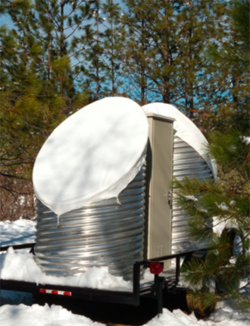
Snow Level Radar
PSL staff designed, built, and deployed a new network of snow-level radars in California. Snow level, the altitude in the atmosphere where snow changes into rain, is a critical parameter influencing runoff in mountainous watersheds because it determines the surface area of the watershed that will be exposed to rain versus snow. When the snow level is above most or all of the terrain in a watershed, a storm is more likely to produce enough rapid runoff to cause flooding. If the snow level is low in a watershed, then a storm increases the snowpack, providing valuable storage of water for potential later use. The snow-level radar (Fig. 1) was designed specifically as part of a project with the California Department of Water Resources (CA-DWR) to provide a 21st century observing systems to help address water resource and flood control issues. This project will apply lessons learned from more than a decade of research on West Coast winter storms conducted by ESRL and partners under HMT, including the first-ever evaluations of operational snow-level forecasts that used an earlier generation of radar technology. The snow-level radar utilizes modernized frequency-modulated, continuous wave (FM-CW) technology, which only uses less than a watt of transmitted power. This dramatically reduces the price of the radar components. The snow-level radar can be built for approximately 1/10th of the price of one of the current state-of-the-art pulsed radars used for the same purpose. The radar operates at 2.835 GHz, which is ideal for measuring the properties of precipitation because at this frequency there is very little weakening of the radar signals by precipitation. Snow-level detection (Fig. 2) is based on an automated algorithm1 developed by CIRES and ESRL scientists. A five-year agreement with CA-DWR calls for ten snow-level radars to be deployed in key watersheds across the state. Four of these radars have already been deployed at or near major California reservoir dams: Shasta Dam, Colfax (above Folsom Dam), New Exchequer Dam, and Pine Flat Dam. Figure 3 shows where these radars are located along with the deployment plan for the six remaining radars. The radars are part of an unprecedented observing network that will provide critical information on the forcings of extreme precipitation and flooding, as well as long-term climate observations to help decision makers adapt to a changing climate.